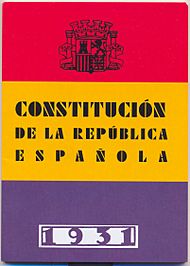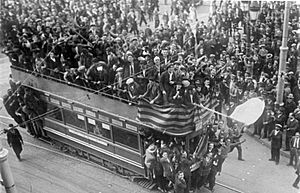Spanish Constitution of 1931 facts for kids
Quick facts for kids Spanish Constitution |
|
 Preface to the Spanish Constitution of 1931
|
|
| Ratified | 9 December 1931 |
| Signers | Niceto Alcalá-Zamora |
The Spanish Constitution of 1931 was a very important set of rules for Spain. It was approved on December 9, 1931. This constitution guided the country during the time of the Second Spanish Republic. This period started on April 14, 1931, and lasted until April 1, 1939.
During this time, both the country's leader (the head of state) and the government's leader (the head of government) were chosen by people voting in elections. This was only the second time in Spanish history that this happened.
The constitution aimed to create a fair and modern country. It wanted a system where everyone had equal rights. It also allowed different regions of Spain to have some independence. Key changes included giving women the right to vote. It also made civil marriage and divorce legal. The constitution said that the government could take private property for public use, but only if the owner was paid fairly. It also made education free, required for all, and not linked to any religion.
Many people hoped this constitution would make Spain more modern and fair. It aimed for a country with clear laws and a sense of social justice. This would help citizens enjoy more freedom and a better life. However, some parts of the constitution, especially those about property and religion, caused disagreements. Some felt these parts gave too much power to the state. They also thought these rules did not protect everyone's rights enough.
The new constitution was seen by some as being against the Catholic Church. It gave many freedoms and democratic rights. But it took away special benefits that the Catholic Church used to have. It also did not specifically protect the Church's interests. There had been growing feelings against the Church for many years. This led to some conflicts and tensions. These issues made the relationship between the Church and the government very difficult. Many historians believe this was a big reason for the problems that led to the Spanish Civil War.
Contents
How the Second Republic Began
The Second Spanish Republic started on April 14, 1931. This happened after King Alfonso XIII left Spain. He left after local elections showed that people in cities mostly voted for candidates who wanted a republic. The King did not officially give up his throne. But his leaving led to a temporary government. This government was led by Niceto Alcalá Zamora. A special group called the constituent Cortes was then formed to write the new constitution.
The start of the Second Republic in 1931 brought great hope for Spanish workers and farmers. There were also some good changes for women. The Prime Minister, Manuel Azaña, believed the Catholic Church was partly responsible for Spain being seen as behind the times. He wanted to remove the special benefits the Church had. Azaña hoped the Second Spanish Republic would be like France's government before 1914. He wanted schooling to be free and required for everyone, and not based on religion.
Key Rules of the Constitution
After elections in June 1931, the new parliament approved the constitution on December 9, 1931.
The constitution brought in several important changes:
- It gave women the right to vote.
- It allowed civil marriage and divorce.
- It made education free, required, and not religious for everyone.
However, some laws also took over properties owned by the Roman Catholic Church. The Church then had to pay rent to use buildings it had once owned. The government also stopped public displays of Catholicism, like parades on religious holidays. It also broke up the Jesuits, a religious group. Catholic schools were banned, meaning nuns, priests, and brothers could not teach, even in private schools.
The constitution also said that the right to own property was not absolute. The government could take private property for the good of the public. But the owner had to be paid for it.
The constitution also gave freedom of religion to everyone. This included allowing non-Catholic religions to worship freely in Spain.
How the Government Worked
The country's leader was the President of the Republic. This President was chosen by a special group of people. This group included members of the parliament and other citizens chosen by popular vote.
The main law-making body was a single assembly called the General Courts (Cortes Generales). Its members were chosen by popular vote for four-year terms. Citizens could also suggest new laws if 15 percent of the country's citizens supported it.
The government's daily work was handled by a Prime Minister (Presidente del Gobierno). The President of the Republic and the General Courts appointed the Prime Minister. The Prime Minister then chose a group of ministers to help run the country.
A special court was created called the Court of Constitutional Guarantees (Tribunal de Garantías Constitucionales). Its job was to make sure laws followed the constitution. It also settled disagreements between different parts of the government.
The constitution also divided Spain into provinces. It allowed provinces with similar cultures to join together. They could then gain some self-rule through a special law called an Autonomy Statute (Estatuto de Autonomía).
Changes for the Catholic Church
The constitution gave many civil liberties and ways for people to be represented. But it specifically removed special benefits for the Catholic Church. Some people thought this was a problem. They believed it stopped a large group of people from fully supporting the new democratic government.
Articles 26 and 27 of the constitution were very important and caused a lot of debate. These articles strictly controlled Church property. They also stopped religious groups from teaching in schools. Many people, including supporters of the Church, saw this as being against Roman Catholicism. Even some who wanted the Church and state to be separate thought these rules were too harsh. For example, José Ortega y Gasset, a famous thinker, said these rules seemed "highly improper."
Pope Pius XI, the leader of the Catholic Church, spoke out against the Spanish government. He said it was taking away the rights of Catholics in his message called Dilectissima Nobis.
In October 1931, José María Gil-Robles y Quiñones, a leader of the political right, said the constitution was 'stillborn.' He called it a 'dictatorial Constitution in the name of democracy.' He wanted to use large public meetings to show the strength of his supporters. He also wanted to prepare them "to fight, when necessary, for the possession of the street."
Two conservative Catholic politicians, Niceto Alcalá-Zamora and Miguel Maura, resigned from the government. They did this when the controversial articles 26 and 27 were passed. These articles controlled Church property and stopped religious groups from teaching.
Historians like Frances Lannon say the constitution caused divisions. She notes that the rules about property and religion focused too much on state power. She felt they did not respect civil rights enough. This made it very hard for Catholic, conservative people to support the Republic. Stanley Payne also agrees that while the constitution gave many freedoms, it did not protect the rights of Catholics as much. This stopped a broad group of people from fully supporting the new democracy.
Some people on the far left did not want to change these parts of the constitution. Because of this, some experts believe that "the Republic as a democratic constitutional regime was doomed from the outset." Many think that this "hostile" way of dealing with the Church and state issues was a major reason for the breakdown of democracy and the start of the Spanish Civil War. One legal expert said that the biggest mistake of the 1931 Constitution was its negative attitude towards the Catholic Church.
Freedom for Other Religions
The Spanish Constitution of 1931 tried to make sure that other religious groups, not just Roman Catholics, had religious freedom. It aimed to stop unfair treatment of Jews and Protestants. However, this freedom was later limited by the Franco government. That government made the Roman Catholic Church the official religion of Spain and stopped other public religious displays.
See also
 In Spanish: Constitución española de 1931 para niños
In Spanish: Constitución española de 1931 para niños
- Spanish First Republic
- Pact of San Sebastián



